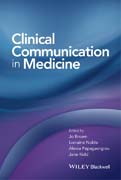
Clinical Communication in Medicine
Brown, Jo
Kidd, Jane
Noble, Lorraine
Papageorgiou, Alexia
Clinical Communication in Medicine brings together the theories, models and evidence that underpin effective healthcare communication in one accessible volume. Endorsed and developed by members of the UK Council of Clinical Communication in Undergraduate Medical Education, it traces the subject to its primary disciplinary origins, looking at how it is practised, taught and learned today, as well as considering future directions.Focusing on three key areas the doctor–patient relationship, core components of clinical communication, and effective teaching and assessment Clinical Communication in Medicine enhances the understanding of effective communication. It links theory to teaching, so principles and practice are clearly understood.Clinical Communication in Medicine is a new and definitive guide for professionals involved in the education of medical undergraduate students and postgraduate trainees, as well as experienced and junior clinicians, researchers, teachers, students, and policy makers. INDICE: Contributors .Foreword .1 IntroductionJane Kidd .Part 1: The doctor–patient relationship .Section lead editor: Lorraine Noble .2 Introduction to the doctor–patient relationshipLorraine Noble .3 History of the doctor–patient relationshipAnnie Cushing .4 Models of the doctor–patient consultationAlexia Papageorgiou .5 What is effective doctor–patient communication? Review of the evidenceGregory Makoul, Sandra van Dulmen .6 Patient–centrednessRosie Illingworth .7 The impact of trainingJohn Skelton .8 The future of the doctor–patient relationshipLorraine Noble .Part 2: Components of communication .Section lead editor: Alexia Papageorgiou .Part 2A: Core tasks in clinical communication .9 Overview of core tasks in clinical communicationJonathan Silverman .10 Relationship buildingJonathan Silverman .11 Information–gathering and clinical reasoningJonathan Silverman .12 Information sharingJonathan Silverman .13 Communication about risk and uncertaintyKatherine Joekes .14 Responding to emotionsTheano Kalavana .15 Sharing bad newsRob Lane .16 Facilitating behaviour change through motivational interviewingEva Doherty .17 Responding to medical error and complaintsLucy Ambrose and Lindsey Pope .Part 2B: Diversity Issues in Clinical Communication and Cultural diversity .18 Overview of diversity issues in clinical communicationCostas Constantinou .19 Diversity issues in communicationMargot Turner, Nisha Dogra .20 The family consultationXavier Coll .21 Children and young peopleXavier Coll .22 The older patientAndrew Tarbuck .23 End of life issuesVinnie Nambisan, Jennifer Balls .24 Mental health mattersJonathan Wilson .Part 2C: Inter–professional communication .25 Inter–professional communication and its challengesSusanne Lindqvist .Part 3 Learning, teaching and assessment .Section lead editor: Jo Brown .26 Introduction to learning, teaching and assessmentJo Brown .27 The history of clinical communication teachingVictoria Bates, Jonathan Reinarz, Connie Wiskin .Part 3A: Models of learning .28 Behaviourism as a way of learningJo Brown .29 Situated and workbased learningJo Brown .30 Experiential learningJan van Dalen .31 Transformative learning and hi–fidelity simulationWesley Scott–Smith .32 Reflective PracticeSally Quilligan .33 Models of feedbackCatherine Williamson, Jill Dales, John Spencer .Part 3B: The assessment of communication .34 Introduction to assessment in communicationJane Kidd .35 Assessing performanceConnie Wiskin, Janet Lefroy .36 Workplace based assessmentJane Kidd, Janet Lefroy .Part 4: Afterword .37 AfterwordJo Brown, Lorraine Noble, Alexia Papageorgiou, Jane Kidd
- ISBN: 978-1-118-72824-6
- Editorial: Wiley–Blackwell
- Encuadernacion: Rústica
- Páginas: 280
- Fecha Publicación: 01/01/2016
- Nº Volúmenes: 1
- Idioma: Inglés
